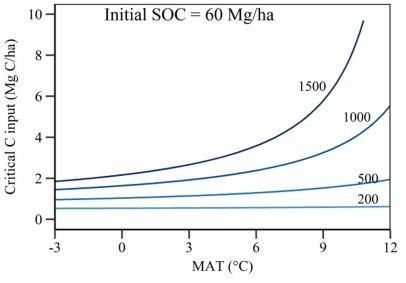
This is a “WordPress” version of a thread that I posted recently on Twitter. I’ve re-posted it here for the benefit of others – and those who may want to find it again in weeks ahead.
In a 2019 column, I calculated that a corn-soybean-wheat rotation would be better for our farm soil than corn-soybean, but only if the wheat straw was not harvested or if a successful red clover cover crop was established, https://tdaynard.com/2019/02/22/can-we-improve-the-soil-sustainability-of-a-corn-soybean-crop-rotation/
But as I’ve realized since then, that’s not the full story. More here..
First the calculations. Anyone can do them. Take average harvested yields, make assumptions about percent crop residues, ratios of root weight and root exudates, and rates of organic matter decomposition.
More sophisticated models include various soil organic matter (SOM) categories and factor in temps and rainfall…
The data and calculations of average annual residue-plus-root contributions to soil for our farm are as follows:

The balance in favour of C-S-W is stronger if one assumes roots and exudates contribute 2.4 times more to SOM than above ground residues (see Rasse et al reference in earlier article). Our data and calculations are as follows:

But there’s more to it than that:
The same calculation procedure for continuous corn would produce a residue+roots+exudates annual contribution of 17,620 kg/ha (29,950 if roots+exudates are 2.4 times more important). That’s far higher than for any rotation (even if corn yields are somewhat lower with continuous corn because of the lack of rotation)…
But I don’t find this benefit for continuous corn in most published data. For example, Chahal et al (https://www.sciencedirect.com/science/article/pii/S016719872100194X) reported soil organic carbon (SOC, upper 15 cm) of 2.31, 2.31 and 2.24 % for corn-only, corn-soy-wheat, and corn-soy-wheat+red clover after 35 years at the Elora Research Station (ON). The differences were were statistically non-significant…
In the same paper, the data for soil organic carbon after 21 years at Ridgetown ON were 2.67%, 2.53% and 2.58% for upper 15 cm for corn-only, corn-soy-wheat, and corn-soy-wheat+ RC. Again, the differences were non significant…
The same dilemma is evident in this paper by Fan et al, https://www.sciencedirect.com/science/article/abs/pii/S0016706118305755?via%3Dihub (model predictions by a research team at Agriculture and Agri-Food Canada, AAFC):
For a mean annual rainfall of 1000 mm and mean annual temp of 7C (typical South-western ON), their model predicts net SOC accumulation if organic carbon addition is above ~2.5 t/ha (~6t/ha of organic matter)..

So that should mean a dramatic increase in SOM with continuous corn on the Daynard farm with 17+ t/ha annual addition (and for most other rotations on our farm too). Unfortunately, that’s something that we definitely don’t see…
Note that in a more recent paper (https://www.researchgate.net/publication/360921647_Prospects_and_challenges_in_the_use_of_models_to_estimate_the_influence_of_crop_residue_input_on_soil_organic_carbon_in_long-term_experiments_in_Canada) the AAFC team acknowledges that their earlier paper over-estimated SOM increases per tonne of OM addition, but the other models they used also still over-estimate what we see on Ontario farms, in my opinion…
So what's this all mean?
In fact, there is ample literature showing that soil organic matter levels depend on far more than annual dry matter additions.
And it can be quite misleading to estimate SOM rotational benefits based on OM additions only – as I did in the 2019 column. 😒
Originally tweeted by Terry Daynard (@TerryDaynard) on September 19, 2022.